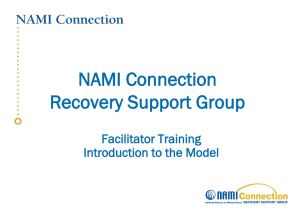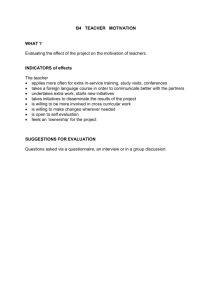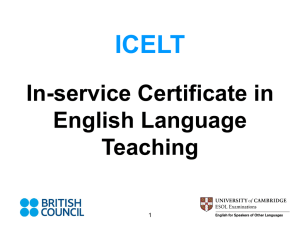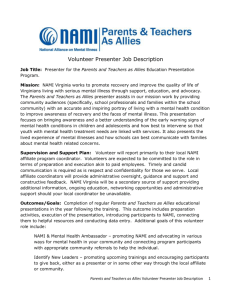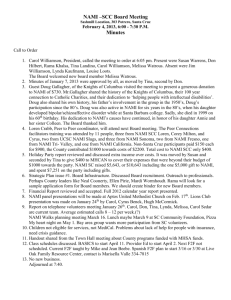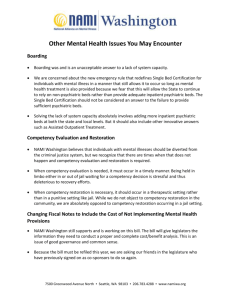How to Fight Back with Your Managed Care Company
advertisement
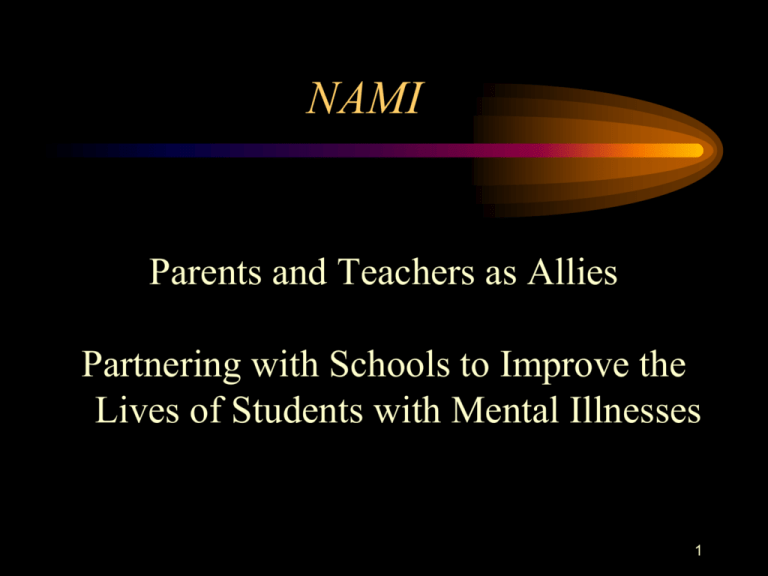
NAMI Parents and Teachers as Allies Partnering with Schools to Improve the Lives of Students with Mental Illnesses 1 The Vital Need for Early Identification of Mental Illnesses… The overwhelming majority of children and adolescents with mental illnesses fail to be identified and linked with services. There are often tragic and avoidable consequences. Many school professionals lack an understanding of early onset mental illnesses. 2 The Role of Schools in Early Identification … NAMI recognized the tremendous value of having parents and school professionals working together as allies… which led to the development of the Parents and Teachers as Allies publication in 1999 (updated in 2008). 3 Parents and Teachers as Allies… The P&T as Allies publication covers the following: – – – – Keys to early recognition and links to appropriate evaluation and services (teachers are never asked to diagnose children or to recommend medications or other forms of treatment); Understanding family reactions to mental illnesses and guidelines for helping families; Navigating the referral process and linking to services as allies; Strengthening the alliance between parents and school professionals and lists resources for both. 4 The Success of the Publication … NAMI leaders recognized the value in sharing the publication with schools and began to use it to better inform school professionals about early onset mental illnesses. Innovative NAMI leaders in a number of states developed an in-service presentation program based on the publication. 5 President Bush’s NFC Recommends Schools Play a Bigger Role … Goal 4 of President Bush’s New Freedom Commission Report on Mental Health, issued in July 2003, calls for schools to play a larger role in the early identification of mental health treatment needs in children and in linking them to appropriate services. This is just what NAMI’s P&T as Allies program targets. 6 The Words of the NFC … “The mission of public schools is to educate all students. However, children with serious emotional disturbances have the highest rates of school failure. Fifty percent of these students drop out of high school, compared to 30% of all students with disabilities. Schools are where children spend most of each day … 7 The Words of the NFC … …While schools are primarily concerned with education, mental health is essential to learning as well as to social and emotional development … Schools must be partners in the mental health care of our children.” (NFC Report, 2003) 8 Why Schools … Schools are in a unique and key position to identify mental health concerns early and to link students with appropriate services. Strong school mental health programs can help to address the needs of students, reduce unnecessary suffering, and help to ensure academic achievement. Goal 4 of The President’s New Freedom Commission on Mental Health 9 Research Supports Early Identification NIMH researchers found that half of all lifetime cases of mental illness begin by age 14, and that despite effective treatments, there are long delays — sometimes decades — between first onset of symptoms and when people seek and receive treatment. Untreated mental illnesses can lead to a more severe, more difficult to treat illness, and to the development of co-occurring mental illnesses. NIMH Funded Research, Released in June 2005. 10 The Focus of NAMI’s School In-Service Program Helping schools to better understand the early warning signs of mental health treatment needs in students and how best to intervene so that youth with treatment needs are linked with services. 11 Outreach for the P&T as Allies In-Service Program • Many schools have not engaged in the MH agenda yet and some resist it. • It may not be a priority for schools. • School professionals are stretched very thin. • Many school-based MH professionals are over-extended, working at multiple schools with huge case loads and some fail to understand early onset MI. 12 Outreach to Schools … • The key to success is to go in to schools knowing the challenges that they face. • We see this task as akin to cultural and social anthropologists – we put ourselves in their shoes. • This program is a beginning to help schools understand the pressing need to recognize the early warning signs of mental illnesses and to link students with services. 13 Outreach … We know that there are many successful ways to conduct outreach with schools. An outreach strategy that works wonders in one district may not work at all in another. A thread of common importance – establish a firm connection with the targeted school and build a relationship of trust. 14 Outreach … Some basic suggestions: • Start where you are most likely to succeed (capitalize on early success, the ripple effect and benefits of the grapevine). • Find your strongest school-based allies. • Find your strongest community allies (other advocacy groups, the PTA, etc.). 15 Outreach … • The advantages and dangers of starting at the top. • Craft your message carefully -- what matters most to this school? • In our experience, school districts are hungry for this information but it can be difficult to make it a priority for them. 16 The Evolution of P&T as A The In-Service presentation follows the content of the P&T as Allies publication, with the lived experience representing a critical component. The In-Service presentation was launched in Orange County, FL (12th largest school district in the country) and has been delivered in multiple sites in states around the country. 17 The Evolution of P&T as A NAMI received a four-year foundation grant to expand the early pilot program. NAMI received additional foundation funding in 2010 to continue to expand the program into new states and new sites within existing states. 18 The Evolution of P&T as A School professionals gave extremely high ratings to the early pilot and subsequent presentations. School professionals often admit feeling ill equipped to address the needs of these students and how best to work with families. 19 Expansion of the Program P&T as A targets public schools in urban, suburban, rural, and culturally diverse communities. NAMI continues to focus on cultural competence in the program. 20 What Does the Program Look Like? • Two-hour in-service education program. • Most schools require school professionals to have in-service training/education . • The program includes a team of four presenters: educator/family member, facilitator/F2F teacher, parent of a child, and an individual who experienced early onset MI. • P&T as A monograph is provided to all participants. 21 Content of the In-Service Program Welcome and Introductions Lead by: Educator/Family Member Speaks from personal experience, warms up the room, connects with the audience as a credible education professional. Focuses on stigma and different perspectives we all have about MI. 22 Content of the In-Service Program Early Warning Signs of Mental Illness Lead by: Facilitator/Family Member Directs group to publication. Reviews the early warning signs. Reinforces that teachers are not diagnosticians but can certainly recognize early warning signs if they know what to look for. 23 Content of the In-Service Program Family Response: Predictable Stages of Emotional Reactions Among Family Members Lead by: Parent/Family Member Reviews stages from the publication (pg. 21-22). Parent recounts their personal journey with their child (infusing the lived experience). Talks about where things are now and steps a school took that were helpful. 24 Content of the In-Service Program Living with Mental Illnesses: A View from the Inside Lead by: Consumer Consumer shares his/her experiences as a child living with mental illness. Focus is on the struggles, especially in school, teachers that helped, what was harmful, what was needed and how bad experiences can be turned around. Professionals are interested in knowing how to properly handle classroom circumstances that they have not been trained to address. 25 Content of the In-Service Program Group Discussion Lead by: Educator/Family Member Everyone on the presenting team fields questions from in-service participants. Presenters are trained to know about the FAQ (differentiating between bad behavior and early warning signs, who do I refer a child to, isn’t medicating a child controversial, how does all this help with classroom management, etc.) 26 Content of the In-Service Program Closing Lead by: Facilitator/Family Member Thanks participants and those who arranged the in-service training. Evaluations for program completed (satisfaction survey and pre- and post-test). We have found that school professionals want much more information (effective behavior interventions, classroom based EBPs, etc.). 27 The Continued Roll-out … Family advocacy leaders participating in the program are receiving ongoing technical assistance from the NAMI national office. This interaction between the field and NAMI provides us with direct feedback on the program’s effectiveness. The evaluation component of the program allows us to measure its ongoing success to help ensure continuous program improvement. 28 NAMI believes that … … together families, school professionals and mental health providers can make a tremendous difference in the lives of children and families. NAMI is pleased to see so many schools opening their doors to family advocates working to raise awareness about early onset mental illnesses. We look forward to continuing to build our partnerships and alliances with the school and mental health advocacy and provider communities. 29 Wise Words ... “ … be the change you want to see in the world. Ghandi 30 Contact Information ... NAMI Education, Training & Peer Support Center Dr. Teri Brister tbrister@nami.org Carmen Argueta carmena@nami.org 31
